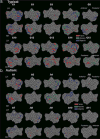Cortical patterns of category-selective activation for faces, places and objects in adults with autism
- PMID: 19360650
- PMCID: PMC2765685
- DOI: 10.1002/aur.1
Cortical patterns of category-selective activation for faces, places and objects in adults with autism
Abstract
Autism is associated with widespread atypicalities in perception, cognition and social behavior. A crucial question concerns how these atypicalities are reflected in the underlying brain activation. One way to examine possible perturbations of cortical organization in autism is to analyze the activation of category-selective ventral visual cortex, already clearly delineated in typical populations. We mapped out the neural correlates of face, place and common object processing, using functional magnetic resonance imaging (fMRI), in a group of high-functioning adults with autism and a typical comparison group, under both controlled and more naturalistic, viewing conditions. There were no consistent group differences in place-related regions. Although there were no significant differences in the extent of the object-related regions, there was more variability for these regions in the autism group. The most marked group differences were in face-selective cortex, with individuals with autism evincing reduced activation, not only in fusiform face area but also in superior temporal sulcus and occipital face area. Ventral visual cortex appears to be organized differently in high-functioning adults with autism, at least for face-selective regions, although subtle differences may also exist for other categories. We propose that cascading developmental effects of low-level differences in neuronal connectivity result in a much more pronounced effect on later developing cortical systems, such as that for face-processing, than earlier maturing systems (those for objects and places).
Figures




Similar articles
-
fMRI investigation of working memory for faces in autism: visual coding and underconnectivity with frontal areas.Cereb Cortex. 2008 Feb;18(2):289-300. doi: 10.1093/cercor/bhm054. Epub 2007 May 20. Cereb Cortex. 2008. PMID: 17517680 Free PMC article.
-
Abnormal activation of the social brain during face perception in autism.Hum Brain Mapp. 2007 May;28(5):441-9. doi: 10.1002/hbm.20283. Hum Brain Mapp. 2007. PMID: 17133386 Free PMC article.
-
The Face-Processing Network Is Resilient to Focal Resection of Human Visual Cortex.J Neurosci. 2016 Aug 10;36(32):8425-40. doi: 10.1523/JNEUROSCI.4509-15.2016. J Neurosci. 2016. PMID: 27511014 Free PMC article.
-
The emergence of the social brain network: evidence from typical and atypical development.Dev Psychopathol. 2005 Summer;17(3):599-619. doi: 10.1017/S0954579405050297. Dev Psychopathol. 2005. PMID: 16262984 Free PMC article. Review.
-
Early functional brain development in autism and the promise of sleep fMRI.Brain Res. 2011 Mar 22;1380:162-74. doi: 10.1016/j.brainres.2010.09.028. Epub 2010 Sep 24. Brain Res. 2011. PMID: 20869953 Free PMC article. Review.
Cited by
-
Social perception in autism spectrum disorders: impaired category selectivity for dynamic but not static images in ventral temporal cortex.Cereb Cortex. 2014 Jan;24(1):37-48. doi: 10.1093/cercor/bhs276. Epub 2012 Sep 26. Cereb Cortex. 2014. PMID: 23019245 Free PMC article.
-
Typical and atypical neurodevelopment for face specialization: an FMRI study.J Autism Dev Disord. 2015 Jun;45(6):1725-41. doi: 10.1007/s10803-014-2330-4. J Autism Dev Disord. 2015. PMID: 25479816 Free PMC article.
-
Face perception and learning in autism spectrum disorders.Q J Exp Psychol (Hove). 2017 May;70(5):970-986. doi: 10.1080/17470218.2016.1151059. Epub 2016 Mar 16. Q J Exp Psychol (Hove). 2017. PMID: 26886246 Free PMC article. Review.
-
The impact of atypical sensory processing on social impairments in autism spectrum disorder.Dev Cogn Neurosci. 2018 Jan;29:151-167. doi: 10.1016/j.dcn.2017.04.010. Epub 2017 May 17. Dev Cogn Neurosci. 2018. PMID: 28545994 Free PMC article. Review.
-
Classification of evoked responses to inverted faces reveals both spatial and temporal cortical response abnormalities in Autism spectrum disorder.Neuroimage Clin. 2021;29:102501. doi: 10.1016/j.nicl.2020.102501. Epub 2020 Nov 30. Neuroimage Clin. 2021. PMID: 33310630 Free PMC article.
References
-
- Aguirre GK, Zarahn E, D’Esposito M. An area within human ventral cortex sensitive to “building” stimuli: Evidence and implications. Neuron. 1998;21:373–383. - PubMed
-
- Avidan G, Hasson U, Malach R, Behrmann M. Detailed exploration of face-related processing in congenital prosopagnosia: 2. Functional neuroimaging findings. Journal of Cognitive Neuroscience. 2005;17:1150–1167. - PubMed
-
- Bailey AJ, Braeutigam S, Jousmaki V, Swithenby SJ. Abnormal activation of face processing systems at early and intermediate latency in individuals with autism spectrum disorder: A magnetoencephalographic study. The European Journal of Neuroscience. 2005;21:2575–2585. - PubMed
-
- Behrmann M, Avidan G, Leonard GL, Kimchi R, Luna B, et al. Configural processing in autism and its relationship to face processing. Neuropsychologia. 2006;44:110–129. - PubMed
Publication types
MeSH terms
Grants and funding
LinkOut - more resources
Full Text Sources
Other Literature Sources
Medical

